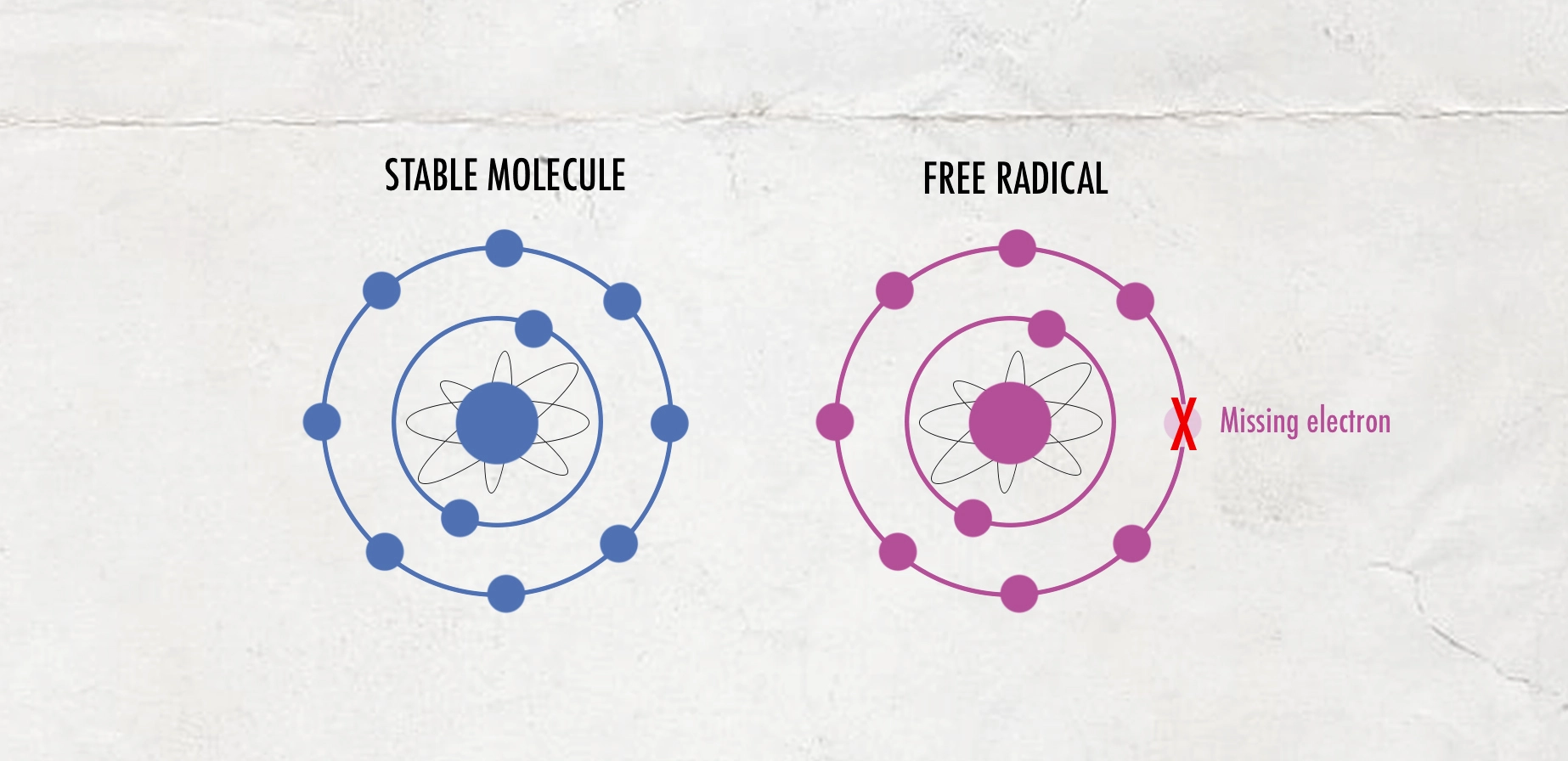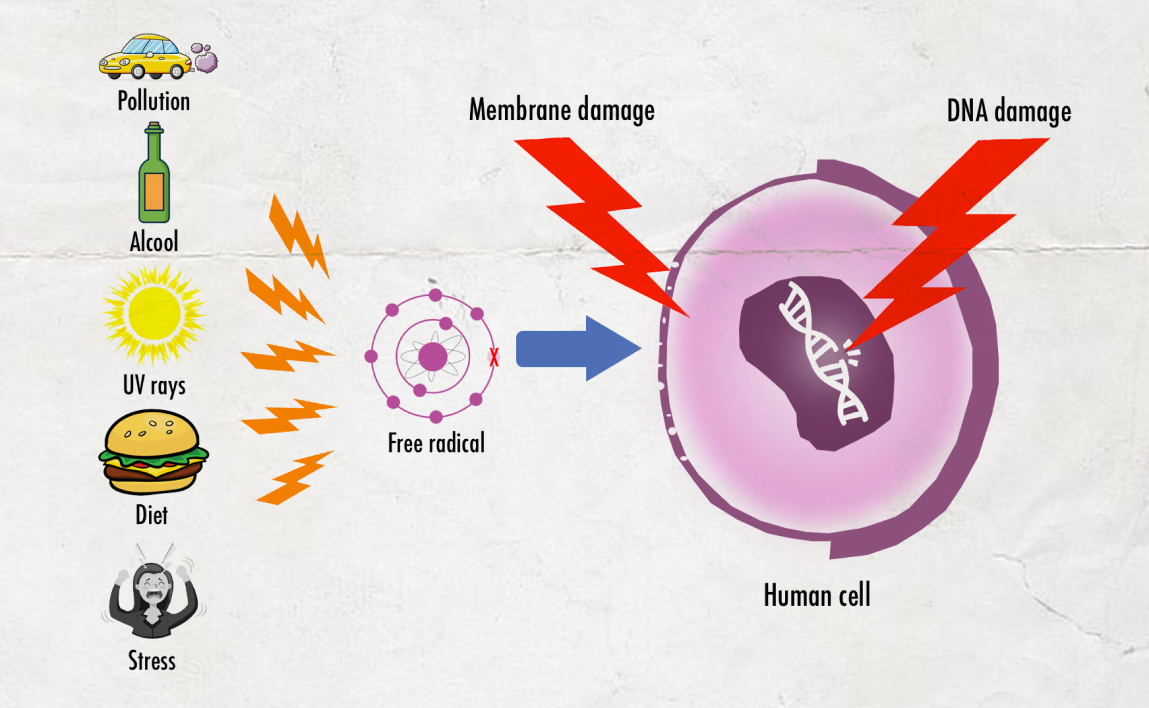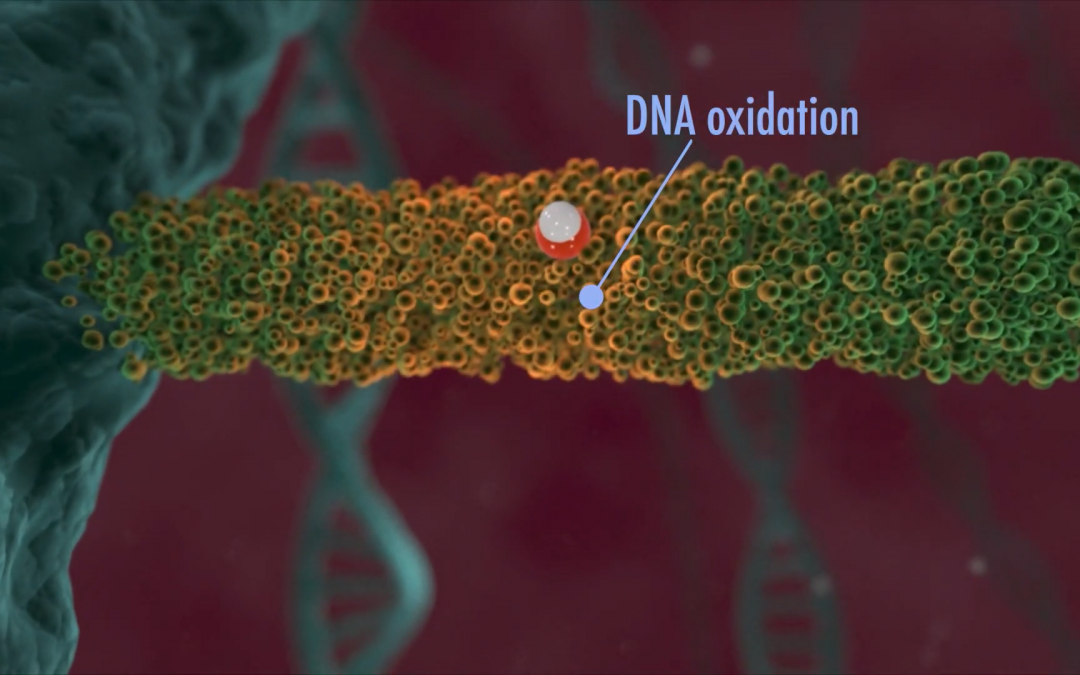Every day, without realizing it, we are constantly flooded with advertisements for a multitude of products – creams, oils, supplements, food – to fight free radicals.
What are these molecules? Why are they toxic for our body? And what countermoves are available to us in this game?
1. The origin of free radicals
Free radicals are molecules sharing a fundamental characteristic: reactivity with other molecules. This is because they have an unpaired electron (an elementary particle with a negative charge) in their outermost region of space (in technical terminology orbital), which makes them molecularly unstable.
In order to obtain an even – no longer unpaired – number of electrons and achieve their own balance, free radicals steal an electron from the stable molecules present in our body. In turn, however, the molecules from which an electron has been stolen will become unstable and therefore they too will hunt for electrons.
This starts a chain process that if not stopped in time by the so-called antioxidant agents can seriously damage our cellular structures.
Among free radicals, the most studied are the so-called Reactive Oxygen Species (ROS), molecules in which the unstable electron belongs to an oxygen atom. The toxic chain reaction induced by oxygen free radicals is therefore called oxidative stress¹.

Figure 1 Comparison between a stable molecule (paired electrons) and a free radical (unpaired electrons).
Where do the free radicals that affect our body come from? There are several known sources of production today, which can be classified into:
– Endogenous sources: free radicals are physiologically and daily produced by metabolic reactions necessary to give energy to our cells and to tackle bacteria and other pathogens2;
– Exogenous sources3: environmental pollutants (e.g. metals and chemicals); smoke, drugs and alcohol; UV rays and radiation; toxic substances generated by cooking food at excessively high temperatures; prolonged mental and physical stress.
Our body has evolved a series of systems called anti-oxidants to inactivate the share of reactive oxygen species that we normally produce during our metabolic and immune reactions.
However, in case of excessive and prolonged exposure to exogenous sources of radicals our antioxidant systems may no longer be enough: let’s imagine a patrol of a small village that in addition to having to keep at bay its criminals suddenly finds itself facing a coordinated raid of criminals from neighboring villages.
Once the endogenous anti-oxidant systems get saturated, free radicals in search of their own stability can go in search of electrons damaging the molecules of our body.
2. Toxic effects
The first targets of free radicals are lipids, the molecules that make up the cell membrane, the outside coat of the cell.
Once the cell membrane is damaged, the cell finds itself uncovered towards the external environment and, if the damage is substantial, it may undergo cell death. The prolongation of this phenomenon over time is one of the main causes of the so-called cellular aging and loss of tone and functionality of our tissues as the years go by4.
Once attacked the cell membrane and entered into the cell, free radicals pass then to destabilize intracellular proteins and the DNA.

Figure 2. Causes and effects of free radicals.
In details, reactive oxygen species interact with the nitrogenous bases that make up our DNA, altering their structure. Our cells recognize the mutated nitrogenous bases and try to repair them, succeeding in most cases. Sometimes, however, the repair does not take place properly: the nitrogen bases affected by free radicals are replaced with wrong ones (mutation) or even cut off (deletion). The long-term increase of free radicals-induced mutations and deletions in different regions of our genome can eventually lead to the development of cancer⁵.
More and more scientific studies also indicate that exposure to sources of free radicals and the resulting oxidative stress are a risk factor for the onset of a very long series of diseases⁶,⁷, including:
- Cardiovascular diseases (atherosclerosis, stroke and heart attack);
- Neurodegenerative diseases (Parkinson’s, Alzheimer’s, …);
- Diabetes;
- Obesity.
3. What countermeasures
So what to do to fight free radicals?
Here is the strategy in 4 steps:
- Reduce exposure to exogenous sources of radicals (pollutants, smoke, alcohol, UV rays, ….);
- Focus on regular and balanced physical exercise. This in fact induces a series of adaptations including the increase of endogenous anti-oxidant systems and the stimulation of DNA repair mechanisms;
- Take care of the inclusion of fruits and vegetables in the diet. These foods contain a significant amount of molecules such as polyphenols, vitamin E, vitamin C, beta-carotenes, selenium and coenzyme Q10⁸,⁹ that by donating or accepting an electron from the free radical break the chain of oxidative stress, thus acting as real anti-oxidants.
Finally, for the pleasure of many of us, it has been demonstrated that cacao has a high content of polyphenols and flavonoids, natural anti-oxidant molecules capable of reducing the onset of cardiovascular diseases.
We can therefore afford to integrate the famous proverb in this way: “An apple and a piece of chocolate a day keep the doctor away!“.
Editorial team– @Nabu Creative Studio
References:
- Oxidative Stress: Harms and Benefits for Human Health. Oxidative medicine and cellular longevity. 2017
- Free radicals and antioxidants in normal physiological functions and human disease. Review. Int. J. Biochem. Cell Biol. 2007
- Free radicals, antioxidants in disease and health. International journal of biomedical science. 2008.
- Effects of antioxidant supplementation on the aging process. Clinical interventions in aging. 2007..
- Role of oxygen radicals in DNA damage and cancer incidence. Mol. Cell Biochem. 2004
- Oxidative stress and Alzheimer disease. Am. J. Clin. Nutr. 2000.
- Possible role of oxidative stress in the pathogenesis of hypertension. Diabetes Care. 2008.
- Antioxidants and prevention of chronic disease. Review. Crit. Rev. Food. Sci. Nutr. 2004
- The emerging role of coenzyme Q-10 in aging, neurodegeneration, cardiovascular disease, cancer and diabetes mellitus. Curr. Neurovasc. Res. 2005.

